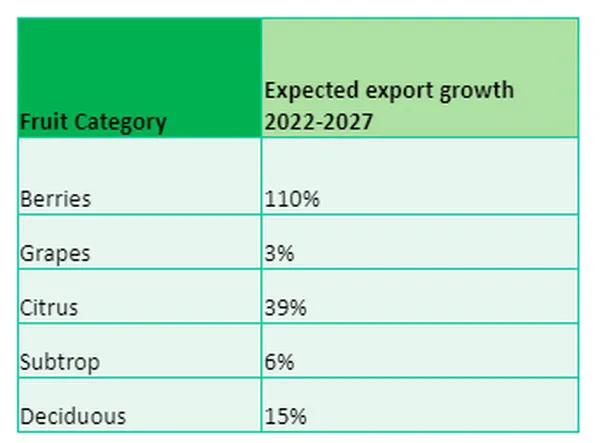As a whole, agriculture comprises 11% of SA exports, despite being only 2,5% of GDP. The overall agri sector is export focused, exporting roughly half its produce in value terms. The South African fruit industry is an overwhelmingly export focused industry, with fresh fruit accounting for around 35% of SA agricultural exports. Decades of R&D and growers and industry association capacity building have gone into producing high quality fruit that can be competitive globally. For example, SA is the world’s 2nd largest citrus exporter; 6th largest pear producer; 7th largest grape exporter; 8th largest apple exporter, and 9th largest avocado exporter.
In terms of export markets, the industry seeks to both retain and maximise its traditional markets within the EU, UK and US, as well as gain access to new markets in East Asia and the Middle East. Citrus comprises the largest export crop, at nearly two thirds, followed by pome fruit, table grapes, stone fruit, and subtropical fruit. South African exporters are keen to enter a broad set of East Asian markets, ranging from India, China and Japan, to Malaysia, the Philippines, Thailand, South Korea and Vietnam. New markets needed for the growing fruit sector – with most commodities expanding production via new plantings which will deliver increased export volumes in near future.

“In some markets such as Japan and China each (citrus) variety has to be presented separately, so each time you go to the back of the queue which can make it a very slow process, but we are making some progress in these markets. In China there is a big demand for South African citrus," said Wolfe Braude from Agbiz.
Currently in the US only citrus from Black Spot free zones can be imported, but Wolfe is hopeful this will change soon. Exports have been increasing to the US as access through different ports has opened up.
Africa is also a potentially big export market for all types of fruit from South Africa. Currently apples and pears are doing well in West and East Africa. The problem with African markets, even with the new Continental Free Trade Area, is ensuring a complete cold chain, as many African countries lack the necessary infrastructure. Excessive border delays and multiple phytosanitary regimes add to risk.
“There has been a lot energy put into the African markets to get the protocols right and streamlining border processes but without cold store facilities it is a big risk for growers, also any border delays would impact the fruit. There is money to be made here, but other regional markets pose much less risk.”
Europe has always been one of the top destinations for South African fruit and will remain so, but the recent changes in protocol for citrus exports have made it very challenging, it has also introduced a certain amount of uncertainty for the fruit exports.
“If the regulations can change so suddenly for citrus, then risk exists for other fruits? The current measures are not justified, but also that there must be room for a fair settlement; an interim measure which is acceptable for both sides, which is why the South African industry supported our government going to the WTO. It is a delicate situation and must be carefully negotiated. In the end it is in everyone’s best interest to have citrus on the shelves for 52 weeks of the year. South Africa is spending around 1.7 billion Rand a year on pest and disease management systems for fruit going to the EU."
With South Africa currently only engaged in Trade Agreement negotiations with India, the industry together with government have as their primary focus the establishment of phytosanitary protocols and agreements with regional markets. Although SA producers therefore do not enjoy the preferential access that many of their peer competitors enjoy, the industry is confident product quality and consistency will allow for consumers in these markets to enjoy SA fruit. Across these set of markets, negotiations are ongoing for a range of fruits, including citrus, stone and pome fruit, litchis, avocados, mangoes, blueberries, persimmons and table grapes. The industry is also in discussions with government around how preferential trade can best be utilised to maximise the sector’s contribution to the national fiscus. The agricultural sector has run a consistent positive trade balance over the last decade.
"Recent successful phytosanitary negotiations have included India for pears, and lemons to China. It is hoped that upcoming BRICS Ministerials and associated meetings will add momentum to the Indian and Chinese negotiations. Although BRICS is not a dedicated trade platform or a trade agreement, there is a commitment amongst its members to increase intra-BRICS trade flows."
The drive to secure more East Asian protocols continues, with South African quality proving its worth – around 29% of apple exports, 23% of pears, 9% of table grapes, 21% of citrus, 45% of grapefruit, 17% of soft citrus and 9% of blueberries were already flowing to the region in 2021. The scope for additional growth across these categories and those who have barely entered the growing market is significant, and much needed, given the expansion of the SA industry and increasing regulatory uncertainty around the EU market, epitomised by citrus.
For more information: Wolfe Braude
Wolfe Braude
AgBiz
Tel: +27 12 807 6686
[email protected]
www.agbiz.co.za










